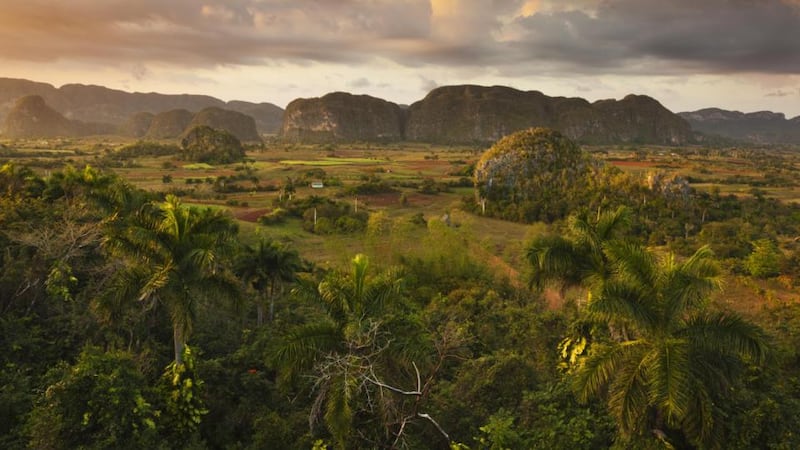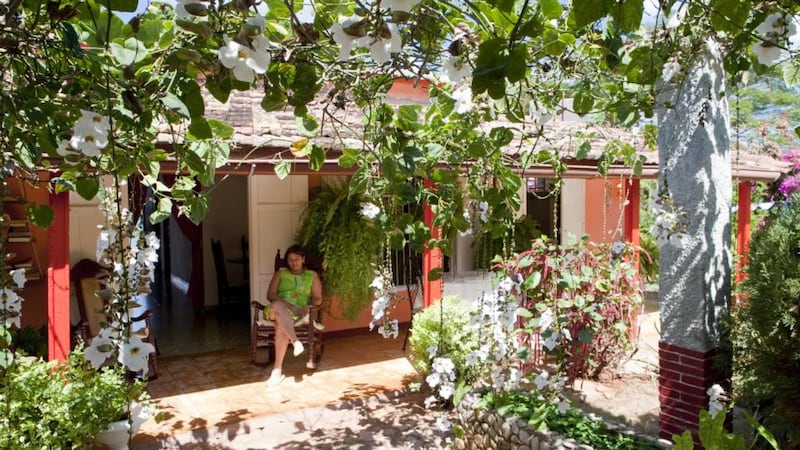As our taxi worked its way into Havana from the airport I was immediately struck by the crumbling streets and faded but stunningly elegant pastel- hued seafront houses. Children played, retired men smoked cigars on park benches and old American cars chugged and spluttered their way along the vast Malecon, a seven-kilometre road and promenade that snakes its way into central Havana. Courting couples, men fishing, and young boys performing acrobats into the Straits of Florida make the Malecon feel like an open-air museum of Cuban life.
Cuba has endless possibilities for creating your own itinerary, from trekking through jungles, lounging on a beach or culture trips to snorkelling on small, mangrove-fringed islands surrounded by warm shallows. Talking to bar owners and Cuban tourists during our three-week trip it was clear the increase of independent accommodation and restaurants in tourist areas is spearheading the growth in tourism.
Travelling independently outside Havana is where Cuba reveals itself to be a gem for the independently minded traveller, especially if you decided to stay in casas particulars, essentially home stays with Cuban families. A room costs €20-€25 a night per person for your own double room with air conditioning (quite often a creaking Soviet machine – loud but effective), along with breakfast and dinner.


Our trip took us from Havana in the northwest of the country to Trinidad, Playa Giron, Playa Larga (Bahia de Cochinos, Bay of Pigs) in the central south. Our last stop was the rural but strikingly tranquil area of Valle de Vinales, on Cuba's left shoulder.
With the window shutters open and the net curtains flapping, you can hear Trinidad slowly coming to life. The bread sellers bellow their mournful tones, and cockerels announce it is morning. The clip-clop of a horse’s hooves passing your room soon fades into to the mosaic of a noisy Cuban town.
Salsa dancing seems to be part of the Cuban DNA and Casa de la Musica in the heart of Trinidad puts on a great show for tourists and locals alike. The long and wide staircase is an unforgettable open-air salsa club, especially with a mojito in your hand. Couples young and old twirl and spin long into the night.
Nearby Playa Ancon is an arc of white sand with the Caribbean lapping at its edge. I was impressed by Playa Ancon but other travellers I spoke to were not. Where else can you arrive in a 1960s Chevrolet, arrange a time for collection and then order numerous Pina Coladas for under €10? There is a large hotel at the beach but I would recommend staying in Trinidad for the best of both worlds.
A magnificent day trip from Playa Ancon was a catamaran trip to Cayo Blanco to snorkel, swim, eat and relax on a pristine stretch of sand, 45 minutes's drive from the coast. Facilities are rudimentary, yet the food was delightful and the beer ice-cold. A sublime day of relaxing.
The lure of the beach had to be resisted for a day, so a taxi was arranged by our casa owner to Parque Caburni, nestled in the Topes de Collantes, among the 90km-long Sierra del Escambray mountain range. The entrance to the park shows the unique socialist idea of a holiday with small neat chalets that have views across the mountains. The only thing to ruin the view is the concrete carcasses of unfinished apartments adjacent to the park. It looks as if the money suddenly ran out, and it probably did, a bit like our own ghost estates.
The jungle walk down is steep, hot and a little slippery. The water holes at the bottom more than makes up for the exertion – just don’t forget your swimwear. Water that is nearly ice cold flows straight from the waterfall into a pool is surrounded by huge boulders. It that makes for a great place to lie, swim or watch the butterflies. Local guides show off their climbing and diving prowess to the steady trickle of tourists.
The Bay of Pigs is best known for the infamous 1961 invasion by the United States using exiled Cubans in the US as a proxy army. There is little to see of the invasion except for an extremely subjective yet fascinating museum at Playa Giron. The museum showcases all manner of things from the invasion. There are captured vehicles and abandoned aircraft but also photographs and documents from the court cases that followed. In the bay there also is a sunken US landing craft to which local diving shops can arrange excursions.
There a numerous casas to stay in at Playa Giron and Playa Larga. Caleta Buena, Punta Perdiz and Cueva de los Peces are small snorkelling spots dotted along the main roads between the two towns. The entrance fee is between €7 – €14 for the day, which includes an all-you-can-drink pass, and lunch if you opt for the €14 pass.
There is no beach to speak of but the sun loungers are spread across a grassy area with paths leading down to the snorkelling holes. Caleta Buenea is unique because freshwater runs into seawater, yielding a full spectrum of underwater creatures. We whiled a few days away at the snorkelling spots, which were rarely busy with tourists except when the odd private European tour bus stopped off.
The road that leads into Valle de Vinales is a winding, twisted artery for the northwest corner of Cuba. The road is lined with towering pine trees in between which you can catch a glimpse of limestone mountains. Oxen work the fields while farmers guide their ploughs with cigars perched expertly on the edges of their lips. I was reading For Whom the Bell Tolls by Ernest Hemingway and the pine trees seemed to mirror the Spanish civil war backdrop he described.
Valle de Vinales is a small town, alive with birdsong in the mornings. The town could rival any tourist area in Cuba for activities. You can climb, hike, cycle and walk across the huge limestone mountains. A stone’s throw from the main street is one of the paths that lead to the tobacco fields where you can take a walking or bike tour.
The pungent, thick cigar smell was overpowering in the enormous tobacco-drying shed. Of course, Cuba being a communist state means the government takes the vast majority of the produce, so the tours allow the farmers to make a little more money from selling cigars, fruit and coffee to tourists. The walk, or horse ride, felt like a nature trail. Piglets scurried across fields, ducks quacked and herons soared among the limestone peaks.
Although Valle de Vinales is inland, it is a short drive from numerous beaches. Buttressed against mangrove forests, the beach of Cayo Jutias can be a lively spot for Cubans, but a short walk along the beach allows you to find a place of solitude.
Snorkelling trips can be arranged from the beach, along with an array of water sports. I love snorkelling and eagerly booked a trip. And what a snorkel experience it was. I jumped in and immediately I knew the only thing with an antennae that big jutting out from under a rock had to belong to a lobster. The trip was for just under an hour and I was back in time to sit in the shallow waters and drink a few pina coladas.
A slightly longer bus ride takes you to the point to catch the 30-minute ferry to Cayo Levisa. After a walk along a wide wooden platform you arrive at the far side, where you find a long, white beach fringed with palm trees and beach huts for overnight visitors. There is less to do here than in Cayo Jutias but the day trips allow you to combine your stay in Valle de Vinales with an island beach break for a day or two.
How to get there: we flew with Air France for €700 per person return from Dublin via Paris. airfrance.com
Where to stay: any town in which we arrived was awash with casa particulares to stay in. There seemed little difference between the vast majority of them, but it may be wise to view a couple to get a feel of the place and location. Typically you will have your own bathroom, entrance, key etc. For me,the food was second to none everywhere we stayed.
Havana: Casa Marta Vitorte www.casamartainhavana.com/ martavitorte@hotmail.com. Tel: +53-7832-6475 or 5246-1323
Valle de Vinales : Casa Omaida Rodriguez algon@princesa.pri.sld.cu. Tel: +4869-6892
Trinidad: Casa Hostal Elio elioramos54@hotmail.com. Tel: +53-5337-6837
Playa Larga: Villa El Paraiso marietaymarian@gmail.com. Tel: +53-45987395
Playa Giron: Casa Mario García Rodríguez (Mayito) mayitogiron1@gmail.com. Tel: +1-5227-9606
Transport: we used public transport throughout the trip. Viazul is the only long-distance public transport available to tourists. Fares are reasonable and the buses have air conditioning. www.viazul.com/ index.php










